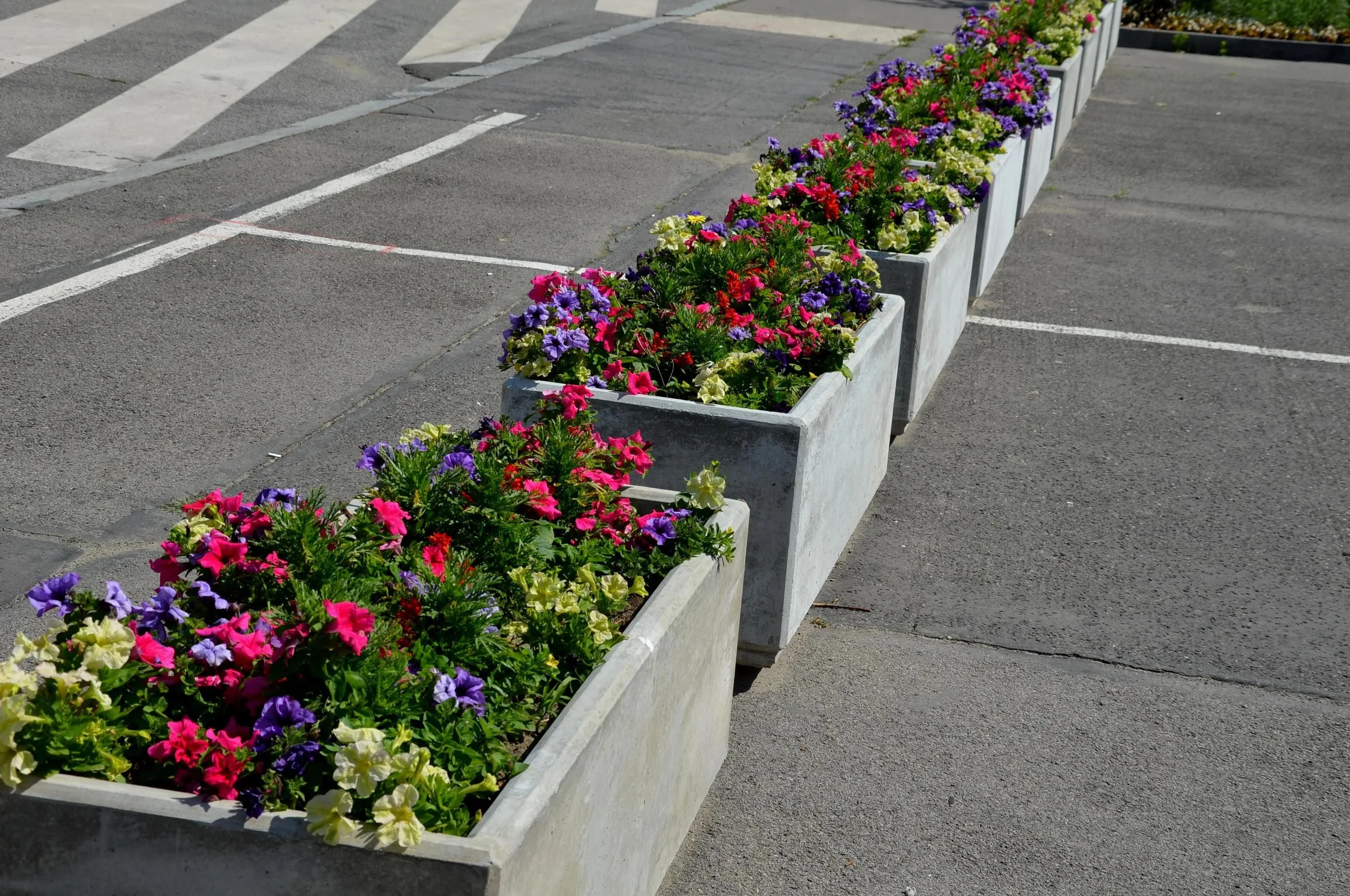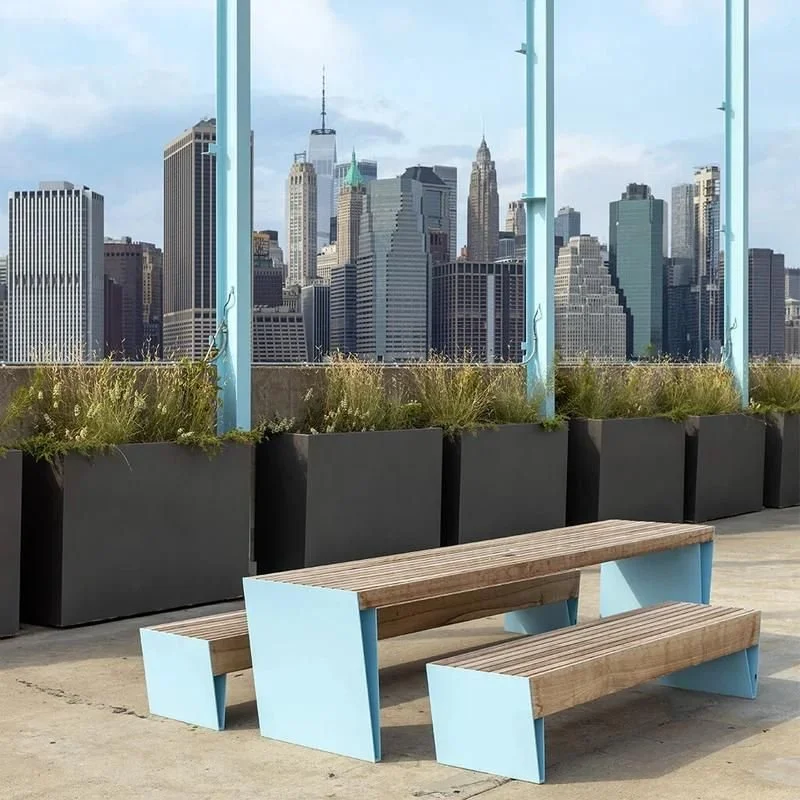Concrete vs. Aluminum Planters: Pros and Cons
When designing an indoor or outdoor space that will include planters, you’ll have many choices to make. But because you’re busy and often pressed for time, picking the right planter material can quickly become overwhelming.
Planter materials vary and can make or break design outcomes (and your reputation) — especially over time. That’s why the expert team at PureModern has assembled this guide about the pros and cons of concrete and aluminum planters so you can make efficient and informed decisions.
Concrete and aluminum are two of the most common materials used in manufacturing planters. Understanding the differences between the two materials will help ensure that you choose the right planter material for your unique project.
Concrete vs. Aluminum Planters
When comparing planter materials, it’s important to find the material that will fit the design project’s needs over time. That process includes assessing each material for various pros and cons.
Concrete vs. Aluminum Planters: The Pros of Each
Both materials will look beautiful at first glance. But it’s critically important to consider other characteristics like weight, customization options, durability, and price.
Plus, the wrong material can impact the health of your plants. Some materials contain chemicals that — if absorbed by the soil — can damage your plantings.
Concrete Planters: The Pros
Heavy Weight. Concrete is a heavy material, which can be a pro or a con, depending on your point of view.
Insulation. Concrete is also a reliable insulator and can protect plant roots during times of significant temperature fluctuations.
Can Be Painted. Another benefit of a concrete planter is that it can be painted to change the appearance over time if necessary. Masonry paint is best.
Limitless Shape and Detail Options. A mold is used to make concrete planters as they are usually poured in place. The details that can appear on the sides of a concrete planter are only limited by your imagination — think flowers or a rope or basket weave pattern. When it comes to shapes, a concrete planter can be even look like a large urn.
Lifetime Product. Concrete planters will outlast most fiberglass, plastic, or wood planters.
Aluminum Planters: The Pros
Lightweight. Aluminum planters are lightweight and therefore, won’t cause structural issues for rooftops, terraces, or decks. This also makes them easier to handle and install. However, if you’re looking for a heavier planter, aluminum planters can be easily anchored or weighted down with crushed stone or large bolts.
Durability. Powder-coated aluminum is durable, won’t crack, and will typically outlast the lifecycle required for the project.
Environmentally Friendly. At the end of the life cycle, aluminum is significantly easier to remove and can even be recycled.
Cost. Aluminum planters are typically more affordable than concrete planters, especially when sizes get larger.
Adaptability. Aluminum is fully customizable with regard to shape, size, and color.
Modern Elite Custom Aluminum Planters at Villa BXV in Bronxville, NY
Concrete vs. Aluminum Planters: The Cons of Each
Concrete Planters: The Cons
Risk of Structural Damage. While concrete may seem like the right choice for large plants that require a certain degree of ballast to protect against strong winds, that weight can cause structural issues for rooftops, terraces, and decks. Plus, the planters themselves are more susceptible to cracking.
Limited Flexibility & Customization. Concrete planters are more challenging to install since you’ll need special equipment to move and place larger planters. And for precast concrete planters, the options for color and finish will be limited — especially when compared with aluminum.
Porous. Concrete is porous, so not a good fit for watertight applications such as interiors.
Cost. Concrete planters are expensive, especially when you compare them against similar aluminum planters. Plus, at the end of the life cycle, concrete is costly to remove.
Aluminum Planters: The Cons
In Extreme Heat Could Possibly Become Hot to the Touch. One disadvantage of aluminum planters is that they can become quite hot in extreme temperatures. Think of patio furniture around a pool that sits in the direct sun and can become hot to the touch. Metal conducts heat, so If you think this may be an issue, consider the following strategies: (Please note that since 2006 we have never had any clients complain that their plants died due to the metal conducting heat and killing the plant roots and we do sell planters to clients in California, Arizona, Texas, and Florida. We have never tested this in-house, but it is possible that the heat from the metal is dispersed throughout the growth medium and does not cause issues for the plant’s delicate roots.)
Position the planters in shady locations.
Cover the inside of the container with a plastic pot liner or foam board insulation.
Leave your plants in the black planting containers and plant them directly into the metal planter. This way, there is a barrier between the roots of your plants and the aluminum should it become very hot.
Shape and Detail Limitations. Aluminum can be bent and shaped in most curved shapes but not into elaborate shapes. Aluminum can be made into round, rectangular, square, or tapered shapes but not shapes with multiple undulations, or intricate weaves, flowers, or delicate rope detailing. The sides of aluminum planters are smooth.
Modern Design. Because of the shape and detail limitations, our metal planters achieve a very modern design and may not align with Old World, Victorian, Gothic Revival, or Art Nouveau styles.
Limited Finish. Aluminum can only be powder-coated with a matte, semi-gloss, or gloss finish. Materials like fiberglass, on the other hand, can be made to look like leather or — by using paint — even aged copper.
Are These Materials Good for Commercial Spaces?
While both concrete and aluminum planters have unique advantages, aluminum planters tend to be the most desirable option — especially when considering design plans for commercial spaces.
Incorporating modern powder-coated aluminum planters will highlight elements of a building’s architecture while adding visual complexity and interest that can significantly enhance your client’s brand.
Aluminum commercial planters also add an elevated and inviting energy to any commercial setting. Plus, commercial aluminum planters can:
Provide a significant return on investment. People feel happier and more energetic after looking at flowers during the morning hours. Studies also show that this boost of energy can last throughout the rest of the day. Research shows that employees, customers, and prospective clients are more likely to spend more time and money in a space that includes planters.
Deliver a host of physiological benefits. From improvements in sleep and immunity to significant progress in cognitive development, the inclusion of plants in commercial settings can show employees and clients how much they are valued.
Help your facility function better. Besides adding color, commercial planters can also help your facility function more smoothly. Commercial planters can also act as buffers for auto and pedestrian traffic. Whether you’re looking to direct guests away from a closed area of your outdoor patio or outline a parking area, using large commercial outdoor planters is much more aesthetically pleasing.
Be customized. Aluminum planters can be customized to fit your space and your watering schedule since access holes for automatic watering systems can easily be drilled.
How to Find the Best Aluminum Planters
You’ll find many planters out there, but not all aluminum planters are created equally.
Most companies offer only in-stock aluminum planters. While these planters might deliver an effective design solution for some, many of our clients require highly customized options.
Needless to say, it is critical to ensure you are working with a company that is highly committed to quality and customer service.
At PureModern, we know you have many project requirements, specifications, and even limitations — like budget or space constraints. But we will work tirelessly with you until you find the right solution.
What you can expect when you work with PureModern:
We provide you with one point of contact with an expert
We can quote most projects same day (typically within 48 hours for larger projects)
Our fabrication lead times are as short as two weeks, depending on the needs of the project
We stand behind all our projects with our Done-Right Guarantee
We follow our Four-Step Proven Project Process
We offer technical expertise for unique custom configurations
We are consultative and responsive with a relational focus
We offer a large selection of high-end, commercial-grade product
Learn More
With so many options, finding the right planter can feel overwhelming — especially for busy landscape designers who are pressed for time.
Contact us to learn more about providing reliable solutions for your next project.






